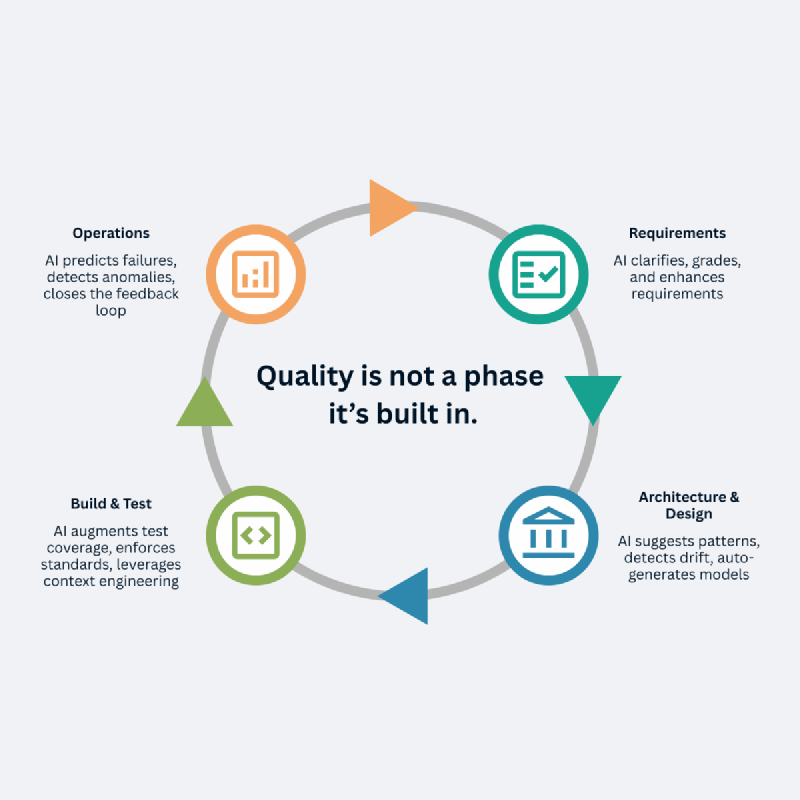Introduction
Too often, enterprises treat quality as a reactionary step during testing. By then, it’s too late – defects are costly, drift is entrenched, and risks multiply. The better path is to treat quality as a continuous discipline, woven through requirements, architecture, build, and operations.
Here’s how quality can – and must – be designed into every stage of the lifecycle, with AI serving as an augmentation layer to scale and strengthen the practice.
1. Requirements: Building clarity from the start
High-quality requirements are the foundation of everything that follows. Yet requirements are often rushed, inconsistent, or ambiguous. To build quality in, we must:
- Ask the right clarifying questions up front.
- Capture requirements in standardised templates.
- Define clear, testable acceptance criteria.
AI strengthens this process by:
- Suggesting questions we may not have thought of.
- Highlighting ambiguities, contradictions, or missing edge cases.
- Grading requirements against quality standards.
- Enhancing acceptance criteria for completeness and clarity.
The outcome: requirements that are sharper, more consistent, and ready to drive quality downstream.
2. Architecture & Design: Guardrails for sustainable solutions
Architecture decisions shape the system’s long-term health. Quality at this stage means ensuring that:
- Critical business needs are mapped to the right architecture characteristics.
- Candidate styles are identified through those characteristics.
- The most appropriate architecture style(s) is chosen for the given problem domain.
- Risks are identified, with mitigations designed in.
- Decisions are captured throughout in Architecture Decision Records (ADRs) capturing the “why”.
- Designs are expressed as living artifacts (e.g., C4 diagrams in mermaid syntax).
- Fitness functions continuously measure the adherence of the implementation to the architecture design.
AI can augment every step here:
- Suggesting architecture options and trade-offs.
- Detecting drift between intended and actual designs.
- Rapidly producing architecture diagrams and design models.
- Grading outputs against standardised practices.
- Architecture artifacts feed context engineering.
By building quality into architecture, we reduce risk, improve alignment, and create strong feedback loops as systems evolve.
3. Build & Test: Raising the engineering baseline
The build and test phases benefit enormously from high-quality context established upstream. Instead of scrambling to “test in” quality, we now have rich context to leverage where we can:
- Use AI to suggest additional test cases, edge cases, and coverage improvements.
- Apply standardised engineering practices (with AI verifying compliance).
- Leverage the testing pyramid effectively to minimise costly duplication.
- Focus humans on high-value work in the problem space, while AI enforces the basics.
- Enable developers to parallelise certain tasks which would in the past be done sequentially.
This is where context engineering and Specification-Driven Development (SDD) shines – combining high-quality context with engineering standards so AI can guide teams toward compliant, consistent, and valuable outputs.
4. Operations: Predict failures, detect anomalies
Quality does not end at release – it extends into how systems behave in production. Operations is where organisations often pay the price for weak upstream practices, but with AI augmentation we can move from reactive firefighting to proactive assurance.
AI enables operations to:
- Predict failures before they occur, allowing preventive action.
- Detect anomalies in real time, spotting drift or unusual behavior early.
- Correlate signals across monitoring, logging, and observability data.
- Feed insights back into design and build, creating a closed-loop lifecycle.
This shifts operations from a cost center into a learning system that strengthens quality everywhere else.
Conclusion: Quality is not a phase
The lesson is clear: quality cannot be tested in – it must be built in.
When quality is designed into requirements, architecture, build, and operations – and when AI augments human expertise at each stage – modernisation becomes safer, more resilient, and more scalable.
This is how we lower transformation risk, empower engineers to innovate, and create a foundation where AI augmentation thrives.
